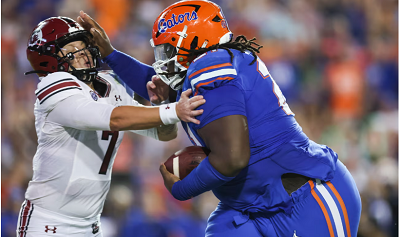In the realm of football, physical size has traditionally been seen as an advantage; however, one must consider the limits of this advantage.
Desmond Watson, a defensive tackle from Florida standing at 6 feet 6 inches and weighing 464 pounds, has emerged as one of the most discussed prospects for the upcoming NFL Draft.
His unique blend of substantial mass and unexpected agility has drawn the attention of scouts, fans, and analysts alike.
Nevertheless, despite his impressive physical attributes, concerns remain Is he excessively large for the requirements of modern NFL play?
Let us thoroughly explore the phenomenon of Desmond, assessing both the opportunities and challenges he presents at the professional level.
What the Future Might Hold for Desmond Watson
It is uncommon for a draft prospect to elicit such polarized opinions. Some regard Watson as a transformative talent, one who has the potential to change the expectations for the defensive tackle role.
Conversely, others perceive him as a physical anomaly whose ability to succeed may be difficult to maintain.

What is evident, however, is that he is entering the NFL under the intense scrutiny of the football community. Every move he makes, every play he participates in, and every sack he achieves will be closely examined.
Regardless of whether he evolves into a dominant player, his influence on the game has already commenced.
Desmond Watson may possess a unique physique, but whether this uniqueness leads to greatness or serves as a limitation remains to be determined.
The Rise of a Giant
Watson, the impressive athlete we recognize today, had a humble beginning. At birth, he was the smallest among his six siblings, weighing only 8 pounds.
However, it wasn’t long before he began to grow, aided by both genetics and environment. With a father who stands 6 foot 4 and weighs 300 pounds, alongside a mother who excelled in basketball, Watson was genetically predisposed for success in sports.
Interestingly, not all of his relatives share his stature. His older brother, Darrian McNeal, a former slot receiver at the University of Oregon, measures just 5-foot-9 and weighs 165 pounds.
Watson remarked, “I come from a family of receivers and running backs, track athletes. I think it was just destined for me to play in the interior.” And indeed, he plays with remarkable strength, presence, and a distinctive physicality.
A Unicorn Among Prospects
When Florida head coach Billy Napier referred to Watson as a unicorn, he was not overstating the case. There is truly no one comparable to him in this year’s draft, or arguably in any recent drafts.
Standing at 6 feet 6 inches and weighing 464 pounds, Watson is on track to become the heaviest player ever chosen in the NFL Draft. For teams aiming to strengthen their defensive line, he offers a unique opportunity.
His stature evokes memories of legendary heavyweights from the past. In the 1980s, William The Refrigerator Perry amazed fans with his rare combination of size and agility.
The 330-pound rookie played a pivotal role in leading the Chicago Bears to a Super Bowl victory and paved the way for larger athletes to emerge as significant contributors.
Likewise, in the 1990s, Nate Newton a 335 pound offensive lineman known as The Kitchenwas instrumental in the success of the Dallas Cowboys dynasty.
These formidable players transformed the perception of what it means to be a lineman. Now, it may be Desmond Watson’s opportunity to shape the future of the position.
Strengths That Can’t Be Taught
What sets Watson apart is not merely his size, but his remarkable agility despite it. His lateral speed, explosive initial burst, and formidable hand strength create significant challenges for offensive linemen.
On tape, he demonstrates moments of exceptional skill disrupting plays in the backfield, filling gaps, and effortlessly collapsing the pocket.
For NFL teams, such raw strength is difficult to overlook. While technique can be taught and endurance can be enhanced, the ability to move 464 pounds with such purpose is an innate quality.
His physique allows him to effectively occupy space, drawing double teams while still managing to impact the play.
Even more noteworthy is his ability to go beyond his physical attributes. He exhibits a surprisingly sophisticated grasp of the game, capable of recognizing offensive schemes and making real-time adjustments. This is a characteristic that coaches highly value in a developing player.
The Concerns Around Conditioning
Desmond Watson’s considerable potential may simultaneously represent his most significant vulnerability. There are valid concerns regarding the sustainability of his size at the professional level.
While athletes such as Vince Wilfork and Haloti Ngata have excelled at weights exceeding 340 pounds, no player has entered the league with dimensions comparable to Watson’s.
The NFL operates at a faster pace than college football, with heightened athletic demands. As a result, conditioning becomes crucial.
The key question is whether Watson can maintain his size while keeping up with the game’s tempo, or if he will need to reduce his weight to remain competitive.
Some scouts express apprehension about his long-term durability. Weighing over 460 pounds on a 6-foot-6 frame may result in chronic joint problems or mobility challenges.
Additionally, there are concerns about his stamina during prolonged drives or in fast-paced offensive scenarios. Consequently, his future may hinge on his ability to effectively manage his body and conditioning.
A Technically Raw Talent
Desmond undoubtedly possesses innate abilities that cannot be taught. However, despite his impressive physical attributes, he appears somewhat unrefined.
At times, he tends to depend excessively on his sheer strength instead of employing more sophisticated techniques. This reliance could pose challenges in the NFL.
At the professional level, blockers are more adept and better equipped, making it difficult to overpower them. If Watson continues to depend solely on his physical prowess without enhancing his fundamental skills, he may face difficulties.
Improvements in his hand placement, leverage, and play recognition will be essential for him to evolve beyond being merely a curiosity.
Moreover, his instinctual approach occasionally leads him to miscalculate angles or take less effective routes to the ball.
While such mistakes may be manageable in college, they can have significant repercussions in the professional arena.
The Right System Could Unlock Greatness
Watson’s prospects in the NFL are likely to be significantly influenced by the system he joins. Certain defensive schemes will align better with his abilities than others.
A 3-4 defense, where he can serve as a nose tackle and concentrate on occupying space and managing the line, may prove to be optimal. Conversely, a fast-paced, gap-shooting 4-3 defense could highlight his conditioning challenges.
Coaching is equally crucial. He will require a coaching staff that is patient, experienced in nurturing unconventional talents, and dedicated to a long-term strategy.
Teams such as the Baltimore Ravens or Pittsburgh Steelers—organizations recognized for their ability to enhance defensive talent—might be particularly suitable.
With appropriate mentorship, Desmond Watson has the potential to become a foundational player for a franchise. However, without such support, he risks becoming a cautionary example of unfulfilled potential.
NFL History Shows a Place for Big Men
Despite Watson’s unconventional profile, the league has a history of large players achieving success. For instance, Orlando Brown, standing at 6 feet 7 inches and weighing 360 pounds, was a dominant force on the offensive line for many years.
Although the current trend in the league favors speed, the importance of power in dominating the trenches remains significant.
Indeed, some of the most successful teams in recent history, such as the 2019 San Francisco 49ers and the 2021 Los Angeles Rams, have centered their defensive strategies around impactful interior linemen.
While these players may not have matched Watson’s size, the fundamental strategy is consistent: control the line of scrimmage, disrupt the opponent’s timing, and exhaust their resources.
If Watson can harness his strengths and refine his gameplay, he has the potential to embody this approach and even enhance it.
Expert Editorial Comment
Desmond Watson’s narrative has engaged the public’s interest in a manner that few draft candidates achieve. His physical stature, personal history, and charismatic personality have made him a darling of the media.
More importantly, he serves as a compelling example of the changing dynamics within football. As the sport strives to find a balance between speed and strength, athletes like Desmond Watson defy traditional expectations.
He transcends the role of a mere football player; he embodies a spectacle, a potential icon, and an enigma all at once. This level of fascination can often hold as much significance as a player’s 40-yard dash time or bench press statistics.
